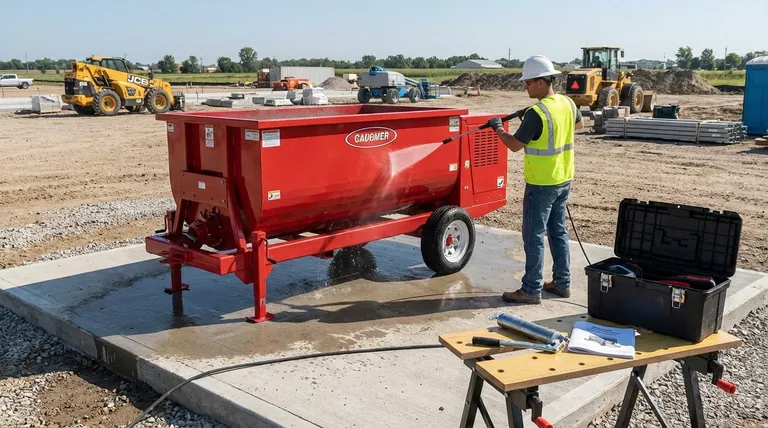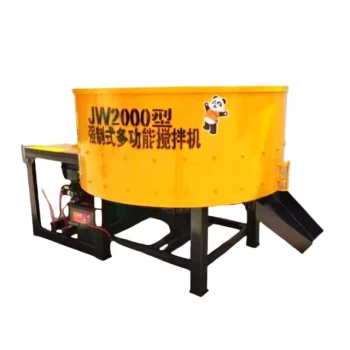Properly maintaining a concrete mixer is a disciplined, multi-step process. It hinges on a strict regimen of daily cleaning to prevent material buildup, consistent lubrication of all moving parts, thorough pre-operation inspections, correct storage, and strict adherence to the manufacturer's specific maintenance guidelines.
The core purpose of mixer maintenance extends far beyond preventing breakdowns. It is a non-negotiable system for guaranteeing the safety of your operators, extending the equipment's service life, and ensuring the quality and consistency of every batch of concrete produced.

The Foundation of Mixer Maintenance: Daily Discipline
A consistent daily routine is the most effective way to prevent costly repairs and ensure reliable performance. These are the non-negotiable tasks that form the bedrock of any maintenance program.
Start with the Manufacturer's Manual
Before any other step, consult the manual provided by the equipment manufacturer. This document is the definitive source for specific lubrication points, maintenance schedules, and operational limits.
Ignoring the manual is the fastest way to void a warranty and cause preventable damage.
The Critical Importance of Daily Cleaning
Hardened concrete is the primary enemy of a mixer. It creates imbalances, damages the drum and mixing blades, and compromises the quality of subsequent batches.
The mixer must be thoroughly cleaned after every use, removing all residual concrete and aggregate before it has a chance to set.
Consistent Lubrication of Moving Parts
All moving components, especially the drum rotation mechanism and tilting gear, require regular lubrication to reduce friction and prevent wear.
Follow the manufacturer's schedule and recommended lubricant types to ensure these critical parts operate smoothly and efficiently.
Pre-Operation Daily Inspections
Before starting work each day, conduct a brief but thorough visual inspection of the entire machine. Look for any signs of wear, damage, or loose components.
If any issues or potential safety hazards are discovered, they must be repaired immediately or reported for service before the mixer is used.
Ensuring Performance and Operational Safety
Effective maintenance is directly linked to the quality of your output and the safety of your work environment. A well-maintained machine is both a productive and a safe one.
Verifying Mix Homogeneity
The ultimate measure of a mixer's performance is the homogeneity of the concrete it produces. Maintenance ensures this consistency.
A clean drum and intact internal blades are essential for the proper distribution of aggregates, cement paste, and admixtures throughout the mixture.
Functional Safety Checks
All safety devices must be verified as fully functional before operation.
This includes testing emergency stop buttons, ensuring safety barriers are in place, and confirming that all warning lights and alarms are working correctly.
Proper Operation as a Form of Maintenance
Incorrect operation is a leading cause of equipment damage. Proper training is a proactive form of maintenance.
Ensuring every operator understands the correct procedures for loading, mixing, and discharging protects the equipment from unnecessary stress and premature failure.
Common Pitfalls and Long-Term Care
Avoiding common mistakes is just as important as performing the right tasks. Long-term reliability depends on a proactive and detail-oriented approach.
Ignoring Small Issues
A minor hydraulic leak or an unusual noise should never be ignored. These are often early warning signs of a larger impending failure.
Addressing small problems immediately is far less costly and time-consuming than dealing with a major breakdown during a critical project.
Improper Storage Between Uses
When not in use, the mixer should be stored correctly to protect it from the elements.
Covering the machine and storing it in a dry, secure location prevents rust, weather damage, and unauthorized use.
Neglecting Operator Training
Assuming an operator "knows" how to run a specific model of mixer is a significant risk.
Formal training ensures the operator is not only efficient but also avoids actions that could damage the hydraulics, engine, or mixing drum.
Making the Right Choice for Your Goal
Your maintenance focus may shift slightly depending on your primary operational priority.
- If your primary focus is maximum equipment lifespan: Rigorously follow the daily cleaning and manufacturer-specified lubrication schedule without fail.
- If your primary focus is consistent concrete quality: Pay special attention to the condition of the drum interior and mixing blades, ensuring they are free of hardened material that affects mix performance.
- If your primary focus is operational safety: Make daily, documented inspections of all safety devices—like E-stops, guards, and lights—the most important step in your pre-start routine.
Ultimately, a disciplined maintenance strategy is the single best investment you can make in your equipment's long-term value and reliability.
Summary Table:
| Maintenance Task | Key Action | Primary Benefit |
|---|---|---|
| Daily Cleaning | Remove all residual concrete after use | Prevents material buildup and drum damage |
| Consistent Lubrication | Lubricate moving parts per manufacturer's schedule | Reduces friction and wear on critical components |
| Pre-Operation Inspection | Visually check for wear, damage, or loose parts | Identifies potential safety hazards and issues early |
| Proper Storage | Store in a dry, covered location | Protects from rust and weather damage |
Maximize the performance and lifespan of your construction equipment. A well-maintained concrete mixer is crucial for project efficiency and concrete quality. GARLWAY specializes in durable construction machinery, including concrete mixers, winches, and batching plants for contractors and construction companies worldwide. Let our experts help you develop a maintenance plan that protects your investment.
Contact GARLWAY today to discuss your equipment needs and ensure your projects run smoothly!
Visual Guide

Related Products
- Ready Mixer Machine for Construction Ready Mix Machinery
- Commercial Construction Mixer Machine for Soil Cement Mixing Concrete
- Auto Concrete Cement Mixer Machine New
- HZS90 Large Multiquip Concrete Mixers for Construction
- JDC350 Small Cement Concrete Mortar Mixer
People Also Ask
- What safety considerations are important for concrete mixer operation? A Guide to Proactive Risk Management
- What should be considered regarding the output of a concrete mixer? Match Capacity to Your Project Scale
- What was significant about Roscoe Lee's 1934 concrete mixer design? Pioneering Modular Construction Equipment
- What is the function of a concrete mixer machine? Achieve Consistent, High-Quality Concrete for Your Projects
- Why is cleaning a concrete mixer after use important? Avoid Costly Repairs and Ensure Quality



















